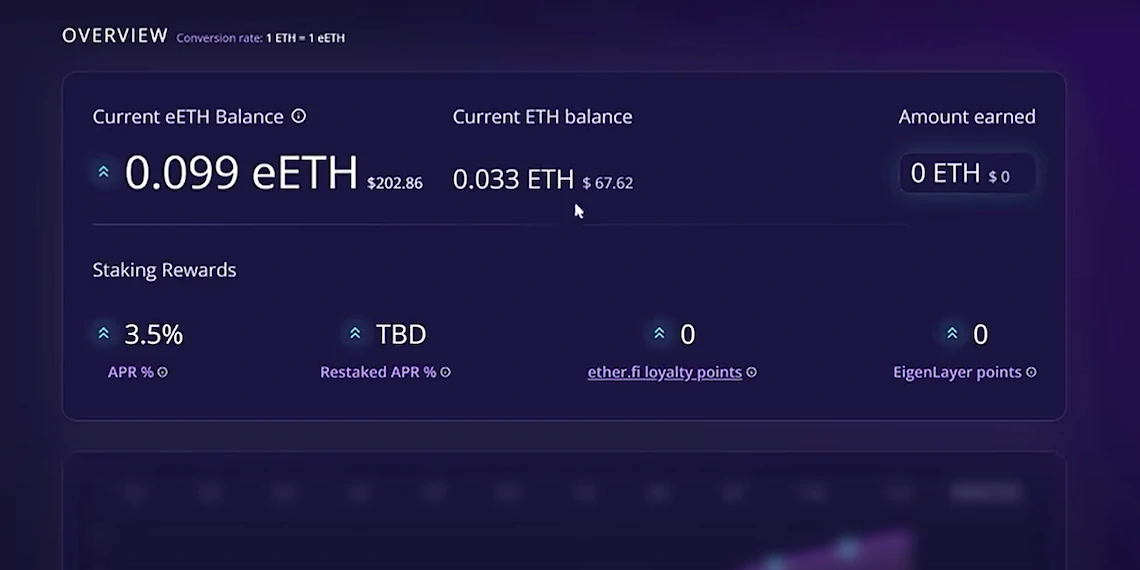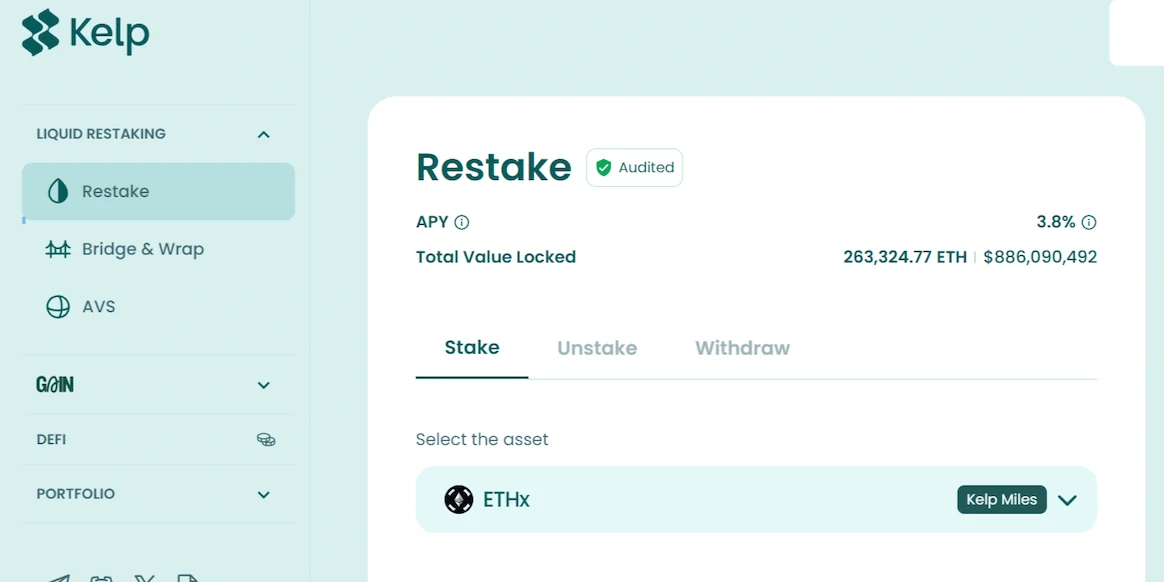ARTICLE AD BOX
What Is Liquid Restaking?
Liquid staking is a phenomenon that has swept the DeFi and crypto world over the past few years and are competing with some of the best crypto staking platforms. It has spawned an entire multi-billion dollar industry off the back of proof-of-stake mechanisms where people lock up their tokens to secure blockchains and receive rewards for participating while maintaining liquidity.
A liquid staking protocol enables you to stake your crypto and receive liquid staking tokens (LST) in return for your original staked assets. You can then earn staking rewards while having liquidity in the derivative token.
The only problem is that receiving liquid staking tokens via a liquid staking protocol are typically lower than those for staking directly to the blockchain. Often, users were frustrated by the lower returns and missing out on potential gains.
So, developers have been quick to find a way to maximize yields without sacrificing liquidity. This birthed the concept of liquid restaking. Users can now take their LSTs and stake them again using another protocol. You then get restaking rewards for staking your LST and mint yet another ‘liquid restaking token’ to use across the DeFi ecosystem.
How Is Liquid Staking Different From Restaking?
Let’s look at a simple breakdown to compare the differences between a liquid staking protocol and restaking:
Traditional staking requires you to lock up assets to secure blockchains and earn rewards. It’s like a fixed-term bank account where the money is locked away and can’t be withdrawn.
Liquid staking protocols give users a new ‘liquid token when they stake your crypto. This represents access to the initial stake and its rewards. But you can also use this in the DeFi world or trade it for other assets.
So, if you decide you want to exit your position on your originally staked crypto, you can sell the liquid token without waiting for your staking period to finish.
Popular Liquid restaking protocols take this one step further, allowing you to double up on your staking activity. It gives you the ability to stake your liquid token for more rewards. Essentially, it is earning more passive income.
How does Liquid Restaking work?
At first, it can be hard to understand how liquid restaking works. It can seem complicated the further you dig into the DeFi staking world. In reality, new platforms make it a simple operation for even ‘non-techy’ users.
Here’s an overview of the process:
- Stake your initial crypto, like Ethereum (ETH), on one of the top liquid staking platforms, and lock it to the blockchain
- Receive LSTs. These represent access and rewards to your staked crypto.
- Restake your LSTs on another liquid restaking platform. This gives you extra rewards to improve yields.
- Receive liquid restaking tokens (rLSTs). These represent access and rewards to your restaked crypto.
The process enables users to take advantage of more yield-generating activities without giving up rewards on their original stakes. It aims to improve capital efficiency and produce compounded earnings for token holders.
These increased rewards make for attractive passive income from a liquid staking token, but they do introduce extra complexity and risk. Users rely more heavily on the underlying protocol security than on direct blockchain staking. In addition, added market volatility exists with smaller market cap tokens. This makes it critical to do thorough research to find the best liquid restaking protocols to reduce risk and hit your goals.
Top Liquid Restaking Protocols Reviewed
The liquid restaking space is growing at lightning speed. Over the last year, the best liquid restaking tokens and protocols have seen eye-watering growth; many have hit multi-billion dollar TVL and market cap. Let’s look at the top available right now:

Ether.fi: Best Liquid Restaking Protocol
Ether.fi is on a mission to make it easy for you to save, earn, and spend your crypto. Its team has built a unique offering with ETH staking combined with a credit card for spending your rewards. So you can earn passive crypto and spend it seamlessly on a Visa card. Plus, you’ll even earn cash back on your online and in-store purchases. It’s a win-win-win scenario.
So how does it all work? Well, you start by depositing your ETH or stETH – stETH being the staking token from Lido. You can then stake your tokens and earn eETH. Then, you have eETH to maximize your rewards further across the DeFi landscape.
If you’re fed up with hunting down the best yields, then there’s a Vaults feature that automatically finds the best protocols to juice your returns. You can just relax and recline while you earn.
With those rewards, you can load them onto a Visa card to make spending crypto in real life easy. Adding to this, you can borrow against your crypto to make purchases on your card. And even pay for the loan balance with your native staking yields.
Ether.fi really is bridging the gap between DeFi and the real world.
- Stake ETH and stETH from liquid staking protocols in return for the eETH token
- Automate yield optimization with the Vault features for better returns
- Spend your staking rewards on the integrated Visa card with cashback bonuses

Puffer: Eigenlayer Liquid Restaking Protocol
Puffer Finance is an innovative staking protocol running on Eigenlayer that aims to make Ethereum staking accessible and more profitable. The platform lowers the barrier for solo stakers to run an Ethereum validator for less than 2 ETH.
The project was founded in 2024 and attracted notable VC funding, including Consensys, Coinbase, and Binance before it finally launched in early 2024. While it’s still a newer platform, this strong backing from the industry and a grant from the Ethereum Foundation show huge long-term potential for Puffer.
Its liquid stake feature is groundbreaking. Usually, when validators stake ETH, it is locked in as collateral – aka, it can’t be used elsewhere. With Puffer, validators receive PufETH as a liquid token to restake across other DeFi protocols.
Puffer is proving hugely popular, hitting over $1.8 billion TVL by mid-2024. For validator nodes, it really is a step forward in boosting yields and accessibility. Protections like anti-slashing technology and permissionless setup add robust security for funds.
- Ethereum validators can stake ETH and receive PufETH tokens to restake elsewhere.
- Industry back and rapid adoption launched its TVL to over $1.8 billion in just a few months.
- The incorporation of anti-slashing technology and permissionless validator setup delivers strong protection for staked collateral.

Renzo: Higher Yields for Liquid Staking Tokens Across Blockchains
Renzo is another top liquid restaking protocol that has deep integration into the Eigenlayer and Ethereum ecosystems. Since its launch in June 2023, it has gained electric growth in the liquid staking category, topping a $4 billion TVL in less than 12 months. Plus, it has gone on to add Solana staking to its features.
The protocol combines robust security with auto-optimized rewards with its staking capabilities. In just a few clicks, you can deposit ETH, stETH, wstETH, jitoSOL, and EIGEN to produce LSTs such as ezETh, pzETH, ezSOl, and ezEIGEN. Then, those tokens can be used on the relevant blockchain apps like Jupiter, ORCA, and Aave, among others.
Or you can simply restake your liquid staking tokens directly on Renzo for auto-compounding gains. It is remarkably easy to produce juicy extra yields from your staking operations using this Renzo and Egenlayer protocol, no matter if you’re an Ethereum or Solana user.
- Deposit and liquid stake several tokens, including ETH, stETH, and jitoSOL.
- Cross-chain capabilities allow you to restake multiple chain tokens in one convenient platform.
- Liquid staking makes it effortless to earn compound rewards in your crypto-earning strategies.

Swell: Maximize Ethereum Liquid Staking Token Rewards
Swell Network is a platform that enables Ethereum stakers to boost passive income by restating their ETH. Developed by Swell Labs, it aims to make financial freedom available to everyone, removing discrimination or censorship from finances.
On the platform, you can both stake and restake ETH. Initial ETH staking yields the swETh token, which can be used across other DeFi protocols. You can also double down with the staking feature within Swell. So you can lock up your swETH and get rswETH. All without ever having to commit to a full 32 ETH validator node.
If you need to use your liquid tokens for other means, then you can use them with Eigenlayer, Liquis, Sommelier, Pendle, and now Lorenzo to optimize and maximize yields.
The Swell Liquid Restaking Council was launched by the Swell DAO to manage the protocol. This represents the community’s committed effort to pursuing the best design, development, and delivery of their innovative feature. The long-term vision is to create the best Ethereum staking expiring in DeFi across both staking and restaking activity.
- You can take advantage of both staking and restaking for Ethereum on one platform.
- Restaking tokens integrate with well-known DeFi protocols like Eigenlayer, Liquis, and Pendle.
- Swell DAO is committed to building a best-in-class protocol that provides a great user experience.

Kelp: Earn Hands-free Airdrop Points
KelpDAO is a liquid restaking platform enabling you to keep custody and utility of your staked tokens in Eigenlayer. It was founded by the original developer behind Stader Labs – one of the top liquid staking services.
On Kelp, you deposit either ETH or liquid tokens, stake them, and receive reETH. It is designed in an attempt to fix the risks and problems with other restaking options. You can then trade tokens, use them as collateral for loans, or a number of other things in the DeFi world. Plus, earn Eigenlayer rewards and points as you go.
The really unique feature is the yield-farming feature. The Gain product gives users a straightforward way to boost yield farming rewards on an expanding list of layer-2 protocols. This is super easy to do by taking the LSTs and depositing it into special vaults, which can deploy them across other networks.
This automatic yielding solution also allows them to earn airdrop points with their vaulted ETH, stETH, ETHx, and rsETH, all automatically. Plus, you’ll then be granted agETH, which represents access to these Gain deposits.
- rsETH is the main liquid restaking token that gives ownership of the Eigenlayer deposits of ETH, ETHx, and stETH while yield farming
- Earn airdrop points for future airdrop rewards, which Kelp doesn’t charge any fees on
- The user interface is comfortable and simple to use without too much technical knowledge required

Mellow LRT: Risk-Adjusted Liquid Restaking P Rewards
Mellow LRT is one of the fastest-growing liquid restaking protocols providing permissionless creation of modular LRTs. What does that mean exactly? You can access a selection of vaults with different risk profiles to earn restaking rewards. This means you can build a custom staking strategy baked on your risk and return preferences.
Within the protocol, developers can build tailored products to reflect low-risk or higher apr-targeted yield rewards across the DeFi landscape. Users can restake Ethereum-based LST, including pzETH, steakLRT, coETH, amphrETH, and more, in exchange for rstETH. Plus, there is a roadmap for the WBTC and USDC vaults, which provide a mouthwateringly wide selection from which to choose for yield investors.
It’s a pioneering design that is taking the restaking industry to a new level of innovation. It only launched in mid-2024 and quickly grabbed $800 million TVL. A sharp focus on security and trust is backed up with security audits from top firms like ChainSecurity and Statemind.
Mellow is definitely one to keep an eye on, and it is ideal for users who want to optimize staking token rewards through an efficient and user-friendly platform. There’s earning potential here.
- Risk tolerance adjustable yield farming for restaking tokens to build tailored strategies
- Automatically integrates with a wide range of DeFi protocols, especially Ethereum-based LSTs
- Trustless and permissionless DeFi investment strategies backed by strong security and audits

EigenPie: Isolated Liquid Restaking on Eigenlayer
Eigenpie is a leading liquid restaking platform based on Eigenlayer. It gives you the ability to restake Ethereum and other LSTs to help validate new services while retaining liquidity. Using Eigenpie, you earn rewards for providing proof-of-stake security to up-and-coming blockchains.
This is an interesting concept that allows token holders to actively contribute to the future of blockchain while also receiving liquid restaking tokens so they don’t miss out on earning potential elsewhere. Adding to this, the protocol uses the EGP token to incentivize users to use the platform when staking, restaking, and conducting governance.
Interestingly, it also has an Isolated Liquid Restaking feature to provide a completely tailored experience for stakers. In simple terms, you can receive rewards from specific LSTs to segregate risk to a single token while protecting your other assets in the protocol. So, if you were to deposit stETH, you would receive an isolated LST for mstETH.
For institutions, Eigenpie runs Eigenpie Enterprise so that companies can securely perform restaking processes while retaining high-level control of their assets. Companies also have the option to select native and liquid restaking to improve capital efficiency while growing the DeFi industry.
- Innovative restaking protocol that supports a diverse range of LSTs that includes stETH, rETH, and mETH.
- Isolated restaking allows users to minimize risk and protect assets while earning specific rewards and tokens.
- DeFi integrates with major protocols like Pendle and Wombat, helping open up further yield options and strategies.

Bedrock: Ethereum and Bitcoin Liquid Restaking Protocol
Bedrock was one of the first multi-asset liquid restaking protocols with backing from leading industry names like OKX, Comma3, and Waterdrip Capital.
The platform allows people to restake different cryptocurrencies like ETH, BTC, and IOTX. Using a universal (uni) standard, it unlocks liquidity and maximizes returns for proof-of-stake tokens alongside assets like wBTC. The simple user interface makes it simple for ‘non-techies’ to restake any amount of tokens to open up immediate liquidity.
It’s rare to see one protocol that offers this flexibility for Ethereum, Bitcoin, and DePin native rewards. Once restaked, you’ll receive either uniETH, uniBTC, or uniOTX. Then it’s off to earn more rewards across Curve, Timeswaps, Penpie, Arbitrum, Pendle, and several more Defi Partners.
Bedrock presents a solid foundation for liquid restaking, giving you access to vastly improved and diversified yield opportunities thanks to its extensive partnerships and collaborations.
- You can restake Ethereum and Bitcoin derivative tokens using the same protocol.
- A wide range of other protocols integrate with the uni liquid tokens for huge investor flexibility.
- The user-friendly platform is easy to navigate and organize staked assets, even for inexperienced DeFi users

Euclid: Mathematically Optimize Restaking Returns
Euclid is aiming to become the new standard for Ethereum restaking. It is building a permissionless and trustless operator network using Eigenlayer. In simple terms, it is a liquid restaking product that uses decentralization to perform its restaking. Building in this manner delivers an easy and cost-effective process to restake your assets.
The platform accepts Ethereum-based LDTs and offers an all-chain liquid token called elETH. Adding to this, the $ECL crypto further rewards users during their restaking period.
It is a comprehensive, risk-minimizing solution that makes the restaking process simple. The protocol also works to ensure deep liquidity for elETH and to give users the flexibility to exit positions when required. This is bolstered by native ETH staking and wide support of LSTs, including ETHx, rETH, stETH, cbETH, swETH, mETH, wBETH, and sfrxETH.
Elucid is a strong choice if you’re looking to maximize your returns when you hold a large selection of LSTs and want to compound your restaking strategy. There’s even a mathematical auto-compounding feature to boost earnings over the long term.
- Permissionless and trustless liquid restaking services across a decentralized network
- Deep support for ETH-based liquid staking derivatives with 8+ different options for users with several tokens
- Validator node operators are protected from accidentally slashing events through tranched delegation.

Inception LRT: Isolated Liquid Restaking Service
Inception LRT focuses on delivering an isolated restaking platform for your staked assets. It’s a targeted restaking method that ensures risk is segregated into individual assets. This modular approach to liquid restaking offers users scalable rewards with enhanced yield strategies.
With Inception LRT, you can tailor and craft your own restaking strategy. Built on Eigenlayer, there is wide asset support with 17+ choices, including ETH, ETHx, tBTC, stETH, and rETH. It’s an intuitive and straightforward user experience. Simply connect your wallet, select your asset, choose your exposure level, and mint your restaking nLRT.
You can then enjoy huge integration to hunt down new opportunities with integrations to 36+ other DeFi protocols, including Uniswap, Beefy, Curve, and Balancer.
If you’re looking to make your LSTs more capital-efficient, then Inception LRT allows you to unlock the full potential of your digital assets in a secure and integrated ecosystem.
- Groundbreak liquid restaking service that allows you to isolate assets and tailor investment strategies
- Huge assets support of 17+ LSTs, including all the major ETH LSTs and tBTC
- Intergration with 36+ other DeFi protocols allows you to build diversified yields
What Is The Best Liquid Restaking Token?
Many people consider Wrapped eETH (weETH) as the best liquid restaking token as it holds a far superior market cap to competitors. In reality, the top liquid restaking token really depends on your previously staked assets. Everybody has a different yield strategy, so it’s important to define your assets and goals when investing. That being said, there are several top performers in the space.
Wrapped eETH (weETH), Renzo Restaked ETH (ezETH), Ether.fi Staked ETH (eETH) and Kelp DAO Restaked ETH (rSETH) are the top Ethereum-based rLSTs.
While Ether.fi Staked BTC (eBTC) and Renzo Restaked SOL (ezSOL) headline as the top liquid restaking protocols for Bitcoin and Solana, respectively.
Benefits of Liquid restaking
Increased Yields
A liquid restaking protocol enables users to earn more rewards by running multiple staking programs simultaneously. Higher yields deliver more significant profits, making your capital work more efficiently.
Flexibility And Liquidity
You can avoid getting locked into a long staking period, instead having the option to exit your position by trading your liquid restaking tokens. This is a handy tool for investors to manage risk in volatile markets.
Diversification
Restaking helps you spread portfolio risk across your staked assets and tokens. It’s another way to balance a portfolio and manage the risk in your investments.
Governance
Several restaking platforms mint you a governance token that gives you a say in the decision-making and future of a protocol. This helps build a positive community that focuses on better rewards and security in the interest of investors.
Risks Associated With Liquid Restaking
Smart Contract Vulnerabilities
Smart contracts can often have bugs or vulnerabilities that hackers use to attack your staked assets. This puts your funds at risk if there is a problem with the code. It is crucial to understand the development of your chosen platforms and ensure they are properly audited by specialist firms
Counterparty Risk
Place trust in 3rd parties platforms adds the risk of these entities failing or even acting with bad intent. Take the time to research project founders and developers to ensure they have a trustworthy reputation.
Market Volatility
Like most cryptocurrencies, the value of staked assets and liquid tokens can fluctuate significantly. You need to pay careful attention to make sure potential market drops don’t outweigh long-term staking yields.
Regulation
Legislation on these innovative protocols is still unclear. Many sit in a grey area in most jurisdictions. Keep a close eye on legal developments and taxable events while investing.
Liquid restaking is an innovative DeFi wave that provides an exciting opportunity for investors to maximize passive earning, making their capital work more efficiently. With the right protocol, you can enjoy higher rewards, flexibility, and diversification in your portfolio.
There are risks to consider, including security and volatility. The best liquid restaking protocols above are the market leaders delivering top returns combined on your staked assets with a robust platform and development teams.
 2 hours ago
184
2 hours ago
184



















 English (US) ·
English (US) ·